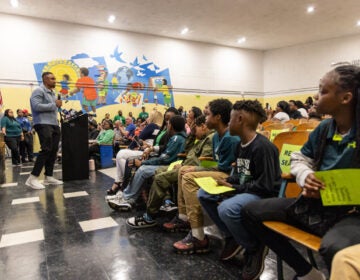Talking poverty, diversity, mental health with America’s principals
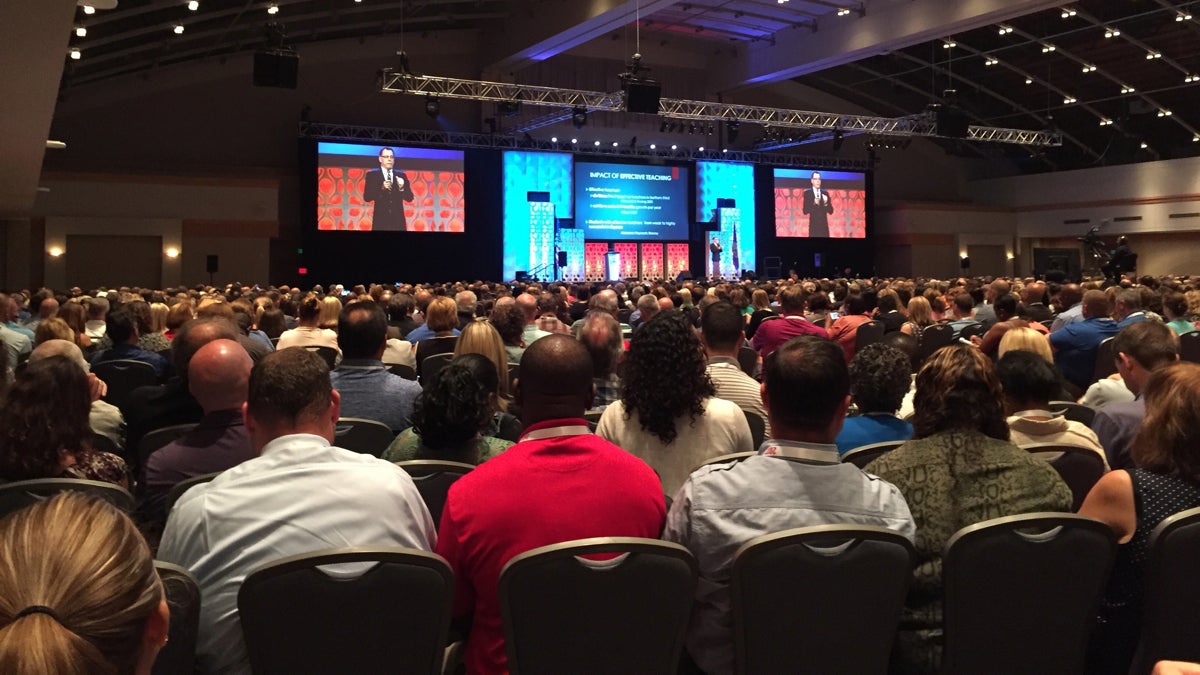
Hundreds of school principals from across the country gather at the Pennsylvania Convention Center for the 2017 National Principals Conference. (Avi Wolfman-Arent/WHYY)
This week thousands of school principals are gathering in Philadelphia for a first-of-its-kind conference.
The 2017 National Principals Conference marks the only time (so far) the National Association of Elementary School Principals (NAESP) and the National Association of Secondary School Principals (NASSP) have held a joint national gathering. Conference attendance is around 4,300, according to an NASSP spokesperson.
Translation: there are a lot of principals roaming Center City right now. (Playing hookie is not advised.)
While they were here, a few principals took time to chat with WHYY. We introduce them below. Together they paint an interesting portrait of American education, both the vast differences and striking similarities among the nation’s many schools.
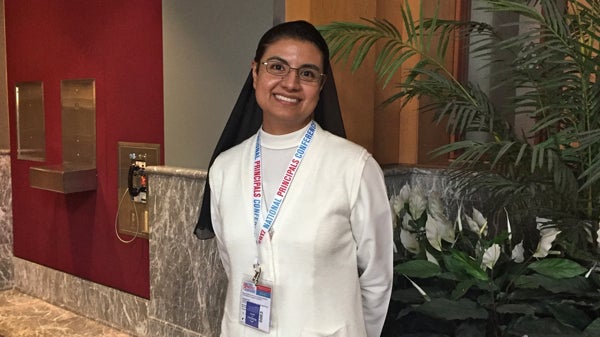
Katia Chavez is principal of St. Mary’s School in El Centro, California. (Avi Wolfman-Arent/WHYY)
Name: Katia ChavezSchool: St. Mary’s SchoolTown: El Centro, California
Describe your school…
It has a very interesting student population because it’s very close to Mexico. So we have a lot of students who cross the border everyday who come to school.
Your biggest challenge is…
The biggest challenge is differentiating instruction so we can achieve student learning.
Something you learned this week…
Teachers need to speak up a little bit more and collaborate amongst themselves, see student work and create lessons that will actually help their own students. You can not really dictate what your students need. You need to see their needs and go from there.
What are you learning from your fellow principals?
We all struggle. And we all have the same questions and we wanna find answers. And we’re looking for them amongst ourselves.
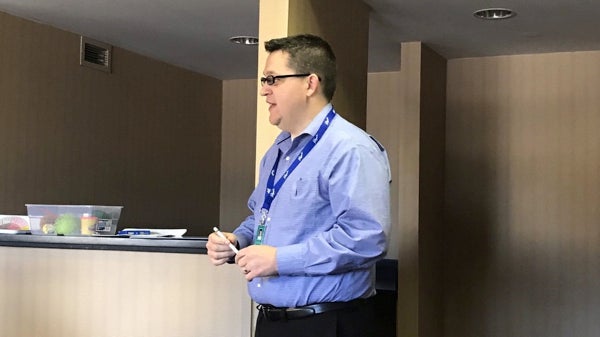 Jethro Jones is principal of Kodiak Middle School in Kodiak, Alaska. (jethrojones.com)
Jethro Jones is principal of Kodiak Middle School in Kodiak, Alaska. (jethrojones.com)
Name: Jethro JonesSchool: Tanana Middle School (transferring from Kodiak Middle School)Town: Fairbanks, Alaska (transferring from Kodiak, Alaska)
Describe your school…
[There’s a] large military population so I’ll be working closely with kids from all over the country to be stationed in the great white north of Fairbanks, Alaska…For the last three years I was the principal of Kodiak Middle School in Kodiak, Alaska — which is an island in the gulf. And so it was a very, unique different experience and something that all these city folk here in Philadelphia don’t really understand. It’s an awesome place to be.
What’s your biggest challenge?
One of the biggest challenges and one of the things we’ve worked really hard to do up in Alaska is recognize when kids are struggling and provide support. Suicide is a really big issue and depression is a really big issue up in Alaska so we do a lot of things to help support students so they’re not struggling with that or they have a way to have a release so they’re not considering taking their own lives.
It’s just a difficult place to live and you are very isolated and oftentimes you feel very alone so it’s important to be able to build connections with the students and let them know that there is a caring adult at the school that will be there to help them whenever they need something.
Something you’re taking away from this week…
It’s really about finding a place to focus and make your impact. It’s so easy to have so many different things that are on top of what we’re supposed to be doing. One of the weak platitudes we have in education is that we “do what’s best for kids.” And that means something different to everybody. So what we really need to do is find out who our kids are. And do what is best for each individual kid.
Note: Jones has a podcast where he interviews other principals. You can check it out here.
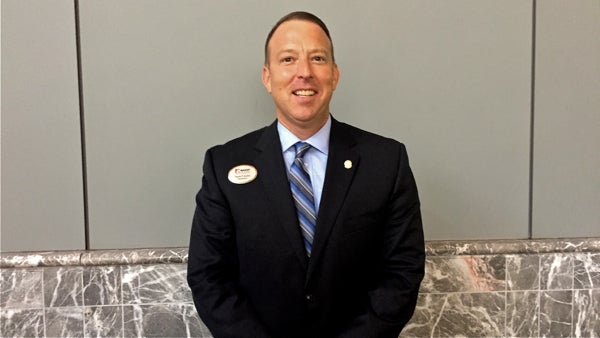
Dan Kelley, president of the National Association of Secondary School Principals, is principal of Smithfield High School in Rhode Island. (Avi Wolfman-Arent/WHYY)
Name: Dan KelleySchool: Smithfield High SchoolTown: Smithfield, Rhode Island
Your biggest challenge?
Right now it’s that relationship between the town side and the school side and trying to get everybody on the same page with a common vision for what schools should look like. We have an initiative right now where they’re looking at reconfiguring our elementary schools. So there’s a ton of conversation.
Best thing about this conference?
The best thing about this conference has been the networking and the ability to connect with principals.
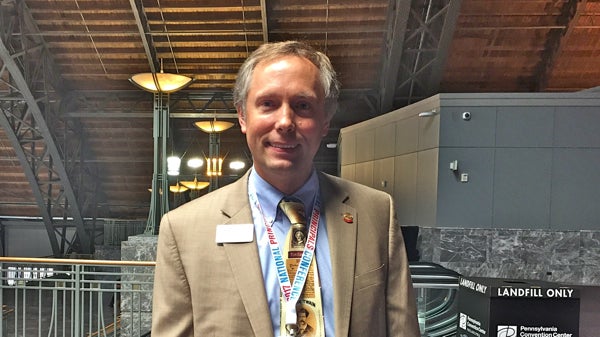 Steven Geis is principal of North Trail Elementary School in Farmington, Minnesota. (Avi Wolfman-Arent/WHYY)
Steven Geis is principal of North Trail Elementary School in Farmington, Minnesota. (Avi Wolfman-Arent/WHYY)
Name: Steven GeisSchool: North Trail ElementaryTown: Farmington, Minnesota
Talk about your school district…
It’s located around 20 miles south of Minneapolis and St. Paul
We have a lot of languages, probably 30 languages spoken in the district. So [there’s] a lot of opportunity to share cultural experiences.
Something you’re thinking about at this conference…
How do we get students reading? How do we detach ’em in this day and age of instantaneous gratification. Whether they have their cell phone or their digital device how do we get ’em engaged just in the true pleasure of reading?
The biggest challenge your school faces…
In my building it’s the mobility…If we can have a student from the duration of that K to 5 they’re going to be on target. They’re going to be on target for graduation they’re going to be at their reading level.
…
You talk about Maslow’s hierarchy and Bloom’s taxonomy. We need to make sure our students are fed, that the school now has become the parent. We’re feeding them in the morning. We’re feeding them at noon and then we’re sending backpacks home with students.
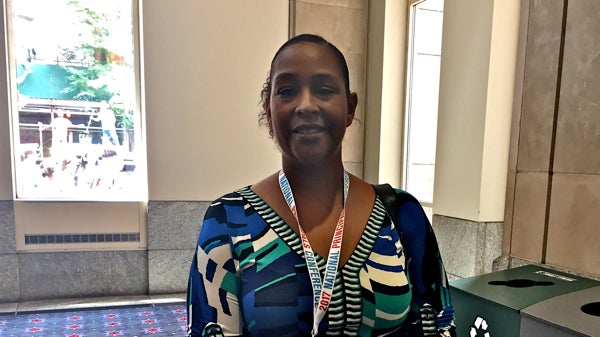 Jamill Jones is principal of Churchland Elementary School in Portsmouth, Virginia. (Avi Wolfman-Arent/WHYY)
Jamill Jones is principal of Churchland Elementary School in Portsmouth, Virginia. (Avi Wolfman-Arent/WHYY)
Name: Jamill JonesSchool: Churchland Elementary SchoolTown: Portsmouth, Virginia
What are you taking way from this week?
We really have to get away from so much technology. Our kids are so much stimulated by technology just because they’re engulfed in it all day long. And so we have to get back to the basics, like having face-to-face conversations.
Your biggest challenge is…
Of course it’s always money, because we never have enough. But we make do with what we have.
What’s it like being with so many other principals?
It just feels good to know that you’re not the only one in the trenches and that we all have the same goals.
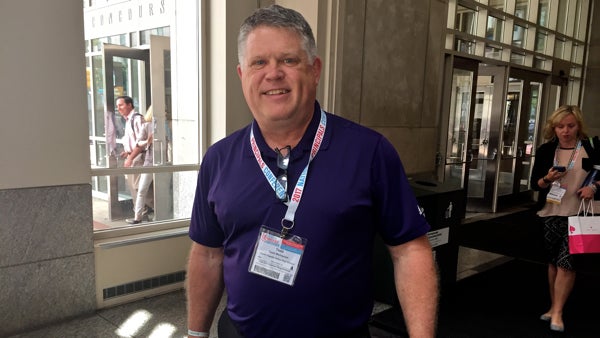 Todd Wolverton is principal of North Fayette Valley High School in West Union, Iowa. (Avi Wolfman-Arent/WHYY)
Todd Wolverton is principal of North Fayette Valley High School in West Union, Iowa. (Avi Wolfman-Arent/WHYY)
Name: Todd WolvertonSchool: North Fayette Valley High SchoolTown: West Union, Iowa
Describe West Union, Iowa…
It’s very much a rural community. Northeast Iowa is very much a rural area–lots of dairy farmers. There’s areas up there that they call the little Switzerland. So it’s very hilly and a very pretty part of the state of Iowa.
What’s your biggest challenge?
I think the big challenge we face is like a lot of small towns in the midwest, declining enrollment. Families, they aren’t choosing to move to small towns. And so we’re always faced with the fact that we’re always looking for more kids and attract more kids. Because our dollars, for the most part, are dependent upon our school enrollment. It isn’t getting any cheaper to provide a high-quality education.
The other thing that I think is a challenge for our school is to attract high-quality teachers. Kids coming out of college — 22, 23 years old — not a whole lot of excitement on the weekends in small-town Iowa.
What are you taking away from this conference?
Right now public education seems to be under attack from so many different directions. I’m gonna get political here, but…our Secretary of the Department of Education (Betsy Devos) is opposed to public education…And so one of the strongest institutions we have in this country — our public education system — is literally under attack from the person leading the organization. And that’s extremely frustrating. I guess one of the things that gives me some hope is listening to a lot of people around the country. I don’t think educators are gonna just stand here and take it.
Talking about rural poverty…
There are so many barriers and so many handicaps that people living in poverty have to overcome and we’re not addressing that problem.
…
Rural poverty is a little bit different than urban poverty. But the barriers to education are just the same. Mom and dad aren’t reading to the kids at night. School’s not the top priority.
What’s it like being with this many principals?
There’s always things you can take away from what you hear from people that make things work. And that’s what I like to do. When I come to these conferences — y’know the researchers they can all go down to that wing and they can talk to other research people. I wanna hear from the people in the field that are working in schools that are making a difference in kids lives so that I can pick their brains
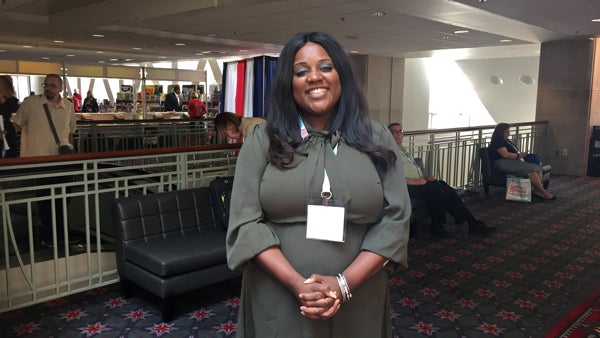 Tamara Stewart is principal of Claymont Elementary School in Delaware. (Avi Wolfman-Arent/WHYY)
Tamara Stewart is principal of Claymont Elementary School in Delaware. (Avi Wolfman-Arent/WHYY)
Name: Tamara StewartSchool: Claymont ElementaryTown: Claymont, Delaware
Tell me about Claymont Elementary…
We serve a very diverse community. We have a large ELL population. …We’re a Title I school. I have about 844 students in my school. We have an autism program. We have a gifted and talented program. We have a Spanish immersion program.
What’s your biggest challenge?
I think the biggest challenge is just creating a culture where everybody feels accepted. Because we have such a diverse population we want to ensure that our staff and our students and our families are all connected.
What’s it like hanging with so many other principals?
I feel like our struggle is the same. We all want what’s best for our kids.
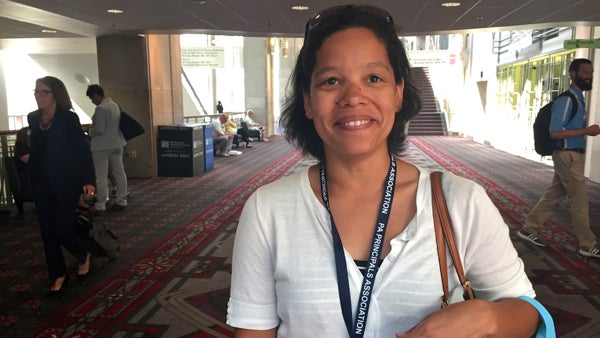 Ilana Shipe is assistant principal of Downingtown West High School in Downingtown, Pennsylvania. (Avi Wolfman-Arent/WHYY)
Ilana Shipe is assistant principal of Downingtown West High School in Downingtown, Pennsylvania. (Avi Wolfman-Arent/WHYY)
Name: Ilana ShipeSchool: Downtingtown West (assistant principal)Town: Downingtown, Pennsylvania
Describe Downintown…
We are a suburban community made up of a wide variety. We have a pretty good diversity base with a lot of different ethnicities, a lot of different religions, a lot of different subcultures all coming together.
What’s your biggest challenge?
Just one? Ok. Currently we’re working on figuring out how we can meet the needs of those diverse learners in a way that makes them feel like they matter. So not just here’s a statistics or here’s what the data says, but how do you as a person feel like you can get it and access it and feel like you’re part of the process?
What are you taking away from the conference?
The idea of simplifying, of not necessarily getting rid of technology, but focusing on what’s proven–what’s most helpful for helping kids achieve. Why shouldn’t we do that more?It helps when the things that I believe are being reinforced with research. (laughs)
WHYY is your source for fact-based, in-depth journalism and information. As a nonprofit organization, we rely on financial support from readers like you. Please give today.



